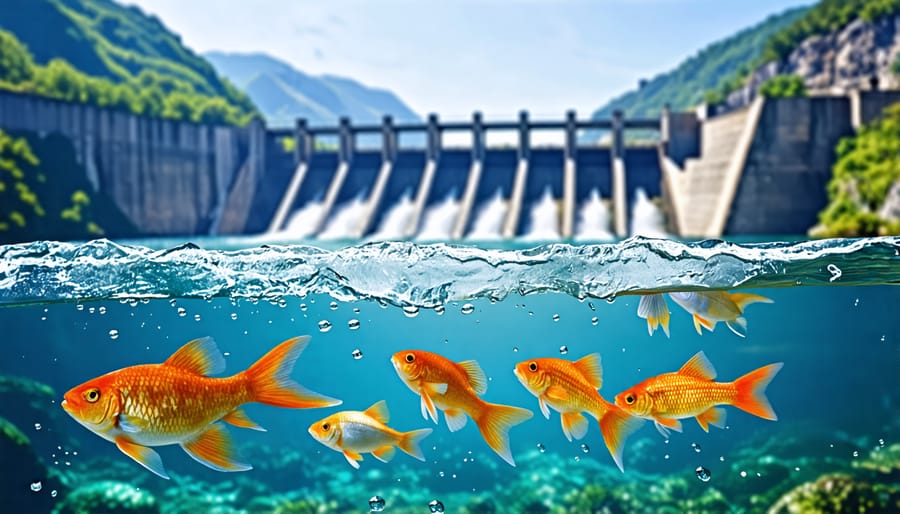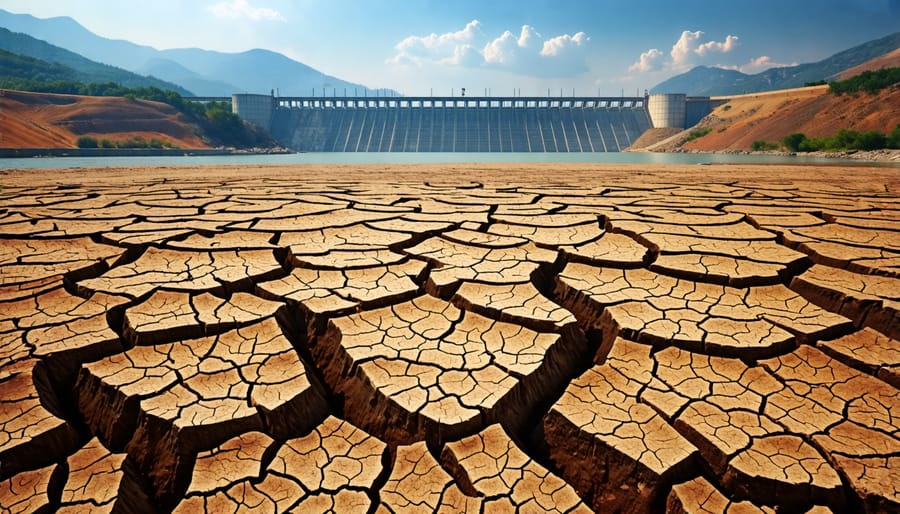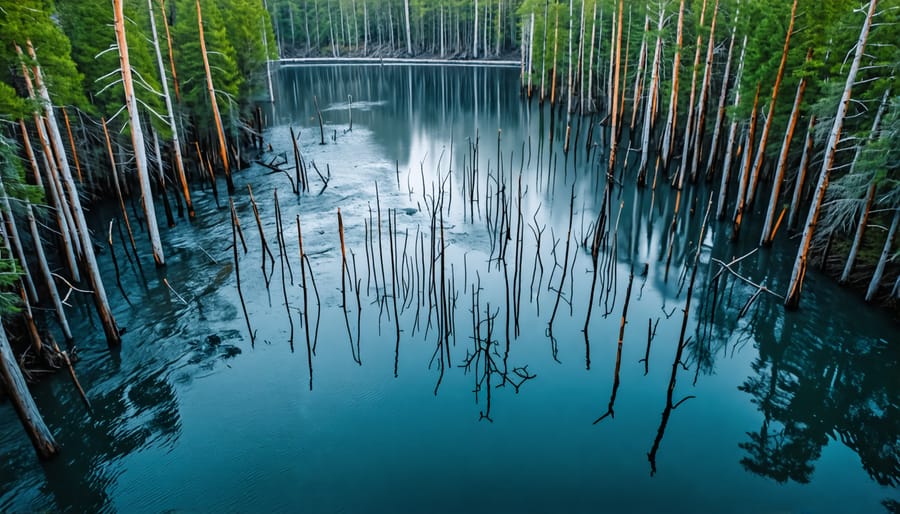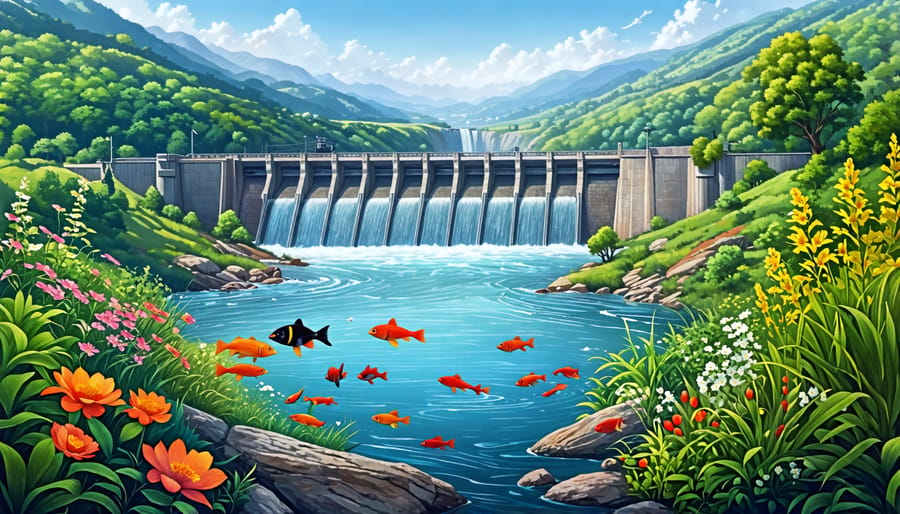While often touted as a clean, renewable energy source, hydroelectric power harbors a dark secret – its profound and far-reaching effects on the environment. From disrupting river ecosystems and decimating fish populations to altering landscapes and contributing to greenhouse gas emissions, the ecological toll of hydropower is both surprising and sobering. In this eye-opening article, we’ll dive deep into the complex web of environmental impacts wrought by hydroelectric dams, exploring how these massive structures irrevocably change the natural world. Brace yourself for a compelling exposé that will make you question everything you thought you knew about the true costs of “clean” energy.
Disruption of River Ecosystems
Impacts on Fish Populations
Hydroelectric dams can have significant impacts on fish populations, particularly migratory species like salmon, sturgeon, and eel. These structures block the natural migration routes that fish rely on to reach their spawning grounds, leading to substantial declines in their numbers. As Dr. Emily Cooper, a fisheries biologist, explains, “Dams create an impassable barrier for fish, disrupting their life cycles and preventing them from reaching critical habitat.”
In addition to impeding migration, dams alter the water conditions in rivers, affecting fish survival. By slowing water flow and increasing temperatures, dams can reduce dissolved oxygen levels and create environments that are less suitable for native fish species. These changes in water quality and temperature can also favor the spread of invasive species, further threatening the delicate balance of aquatic ecosystems.
Fish that manage to pass through or over dams often suffer high mortality rates due to turbines, pressure changes, and disorientation. While some dams include fish ladders or elevators to help fish navigate around these obstacles, their effectiveness varies greatly depending on the species and the specific design of the passage facilities. As a result, even with mitigation measures in place, many fish populations continue to struggle in the presence of hydroelectric dams.

Effects on Other Aquatic Life
The impacts of hydroelectric dams extend beyond fish to affect a wide range of aquatic and semi-aquatic species. Amphibians, such as frogs and salamanders, rely on the natural flow and temperature variations of rivers for breeding and larval development. Dams can disrupt these cycles, leading to population declines. Similarly, many reptiles, including turtles and crocodilians, depend on specific riverine habitats that may be altered or destroyed by dam construction and operation.
Aquatic insects, the foundation of riverine food webs, are also vulnerable to hydropower’s effects. Changes in water flow, temperature, and oxygen levels can disrupt insect life cycles and reduce biodiversity. This, in turn, affects the many fish, birds, and mammals that feed on these insects.
Plants, too, are impacted by hydroelectric dams. Riparian vegetation, adapted to natural flood cycles, may struggle to survive with regulated water levels. Submerged aquatic plants can be smothered by sediment build-up behind dams or scoured away by altered flow patterns. These changes in vegetation affect the entire ecosystem, from nutrient cycling to habitat availability for other organisms.
By disrupting the intricate balance of riverine ecosystems, hydroelectric dams can have cascading effects on a multitude of aquatic and riparian species, underlining the need for careful consideration and mitigation strategies in hydropower development.
Downstream Effects and Erosion
Altered Flooding Cycles
Natural flooding cycles play a vital role in maintaining the health and biodiversity of riverside ecosystems. These periodic floods replenish nutrients in the soil, disperse seeds, and create diverse habitats for various species. However, the construction of hydroelectric dams disrupts these natural cycles by regulating water flow and preventing floods.
The altered flooding patterns can have significant impacts on riverside vegetation and habitats. Without regular flooding, the composition of plant communities along the river banks may change, favoring species adapted to more stable conditions. This shift can reduce biodiversity and alter the ecosystem’s balance. Additionally, the lack of periodic inundation can lead to the drying out of wetlands and floodplains, which serve as crucial habitats for many species.
Furthermore, the disruption of flooding cycles can affect the reproduction and survival of certain fish species that rely on seasonal floods for spawning and migration. The changes in water temperature and flow patterns caused by dams can also impact the growth and development of aquatic organisms.
While hydroelectric power offers benefits as a renewable energy source, it is essential to consider and mitigate its effects on natural flooding cycles to preserve the health and biodiversity of riverside ecosystems.

Delta and Coastal Erosion
Hydroelectric dams can significantly alter the natural flow of sediment in rivers, leading to far-reaching consequences downstream. When a dam is constructed, it traps sediment that would otherwise be carried by the river to the delta and coastal areas. This disruption in sediment transport can result in severe erosion of river deltas and nearby coastlines.
The impact of reduced sediment flow is particularly evident in the Nile Delta, where the construction of the Aswan High Dam has led to substantial coastal erosion. Before the dam’s construction, the Nile River carried approximately 124 million tons of sediment to the delta each year. However, after the dam’s completion in 1970, this figure dropped to a mere 0.5 million tons per year.
The loss of sediment supply has caused the Nile Delta to shrink and subside, making it more vulnerable to rising sea levels and storm surges. According to a study by the University of Colorado, the delta is sinking at a rate of 3-5 mm per year, which, combined with sea-level rise, could lead to the displacement of millions of people in the region by 2100.
This pattern of erosion and subsidence is not unique to the Nile Delta; it can be observed in many other river deltas worldwide that have been impacted by hydroelectric dams. As the world continues to grapple with the consequences of climate change, it is crucial to consider the long-term effects of hydropower on fragile coastal ecosystems and the communities that depend on them.
Emissions and Land Use Changes
Methane Emissions from Reservoirs
When vegetation is submerged under water in hydropower reservoirs, it begins to decompose due to the lack of oxygen. This process releases methane, a potent greenhouse gas that has a warming potential 28 times greater than carbon dioxide over a 100-year period. According to a study by Washington State University, methane emissions from hydropower reservoirs can be substantial, particularly in tropical regions where the warm temperatures accelerate decomposition.
The amount of methane released depends on factors such as the type and quantity of vegetation, water depth, and climate. Shallow, vegetated areas tend to emit more methane than deep, clear waters. Researchers estimate that globally, reservoirs are responsible for about 1.3% of human-caused greenhouse gas emissions. While this may seem small compared to other sources like fossil fuels, it challenges the notion that hydropower is entirely clean and carbon-neutral.
Strategies to mitigate reservoir methane emissions include clearing vegetation before flooding, aerating the water to promote decomposition, and capturing the methane for energy production. As the world seeks to transition to low-carbon energy sources, understanding and addressing the complex environmental impacts of hydropower will be crucial for informed decision-making and sustainability.
Deforestation and Habitat Loss
The construction of hydroelectric dams often leads to significant land use changes and habitat destruction. When rivers are dammed to create reservoirs, vast areas of land are flooded, submerging forests, grasslands, and other ecosystems. This flooding can displace wildlife, destroy critical habitats, and disrupt ecological balances. For example, the Three Gorges Dam in China flooded over 600 square kilometers of land, causing the loss of numerous plant and animal species.
Moreover, the altered water flow patterns downstream of dams can lead to further habitat degradation. Reduced water levels and changes in seasonal flooding cycles can harm riparian zones, wetlands, and floodplains that many species depend on. These changes can also facilitate the spread of invasive species, further threatening native biodiversity.
The loss of forests due to reservoir flooding is particularly concerning, as it contributes to carbon emissions and reduces the Earth’s capacity to absorb atmospheric carbon dioxide. According to a study by the National Renewable Energy Laboratory, the carbon footprint of hydropower can be significant when considering the emissions from reservoir flooding and the loss of carbon sequestration potential from submerged vegetation.
To mitigate these impacts, careful planning and environmental impact assessments are crucial when selecting sites for hydroelectric projects. Strategies such as minimizing the flooded area, protecting critical habitats, and implementing reforestation programs can help reduce the ecological toll of hydropower development.

Conclusion
Hydroelectric power, while providing a significant source of renewable energy, has wide-ranging environmental impacts that must be carefully considered and mitigated. From disrupting river ecosystems and fish populations to altering erosion patterns, water quality, greenhouse gas emissions, and land use, the effects are complex and interconnected.
As the world seeks to transition to cleaner energy sources, it is crucial that we understand these impacts fully in order to develop more sustainable hydropower practices. Thorough environmental impact assessments, innovative fish passage solutions, strategic dam placement, and watershed management strategies can help minimize the ecological footprint of hydroelectric projects.
Looking forward, the hydropower industry must prioritize working closely with environmental experts, local communities, and policymakers to strike a balance between energy production and ecosystem preservation. By investing in research, embracing new technologies, and implementing best practices, we can harness the power of moving water while respecting the delicate balance of nature.
The path to truly sustainable hydropower is not easy, but it is a challenge we must undertake if we hope to meet our energy needs without sacrificing the health of our rivers and the biodiversity they support. With careful planning, collaboration, and a commitment to environmental stewardship, a future where hydropower and healthy ecosystems coexist is within reach.

